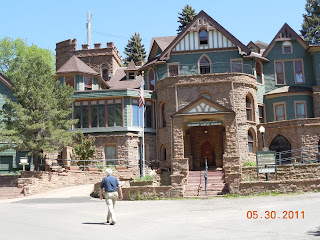 |
| Great Sand Dunes National. Park and Preserve |
From the Rocky Mountain National Park to the beauty of Manitou Springs and Miramont, your Colorado vacation will be a fascinating experience.
Great Sand Dunes National Park & Preserve is located 35 miles northeast of Alamosa, Colorado. This is in the southern part of the state relatively near the New Mexico border.
Getting to the Great Sand Dunes National Park
Some tips for your Colorado trip planner. If you're traveling from the Denver area, Colorado Springs, or Pueblo, the best route is south on Interstate-25 to Walsenburg, then west on US 160 and then north on State Highway 150. If you're looking for a more mountainous trip from Denver you can travel US 285 south, then on State Highway 17 south, then County Lane 6 east from Mosca. Many people also drive up from Santa Fe and Taos New Mexico. From Santa Fe drive north on US 285 to Alamosa Colorado. From Alamosa, you can take either U.S. Highway 160 east and State Highway 150 north, or State Highway 17 north and County Lane 6 east from Mosca. Mileages are about 240 from the Denver area and 185 from Santa Fe.
There are so many companion trips to add to your Great Sand Dunes visit that they're almost too many to list. Before any of these however I would recommend staying at the Colorado dunes until sunset. Sometimes you can see what many say are the best sunset views anywhere. I did this during my visit to the Dunes and it was well worth it.
The Area of the Great Sand Dunes
What we do know about the Great Sand Dunes in Colorado is that they were first noticed by the Native Americans in the area. The names and languages of these earliest natives are not known, more recent American Indian tribes were quite familiar with the area when the Spaniards first arrived over 400 years ago.
As an example, the traditional Ute Indian word for the Great Sand Dunes is Sowapophe-uvehe, "the land that moves back and forth". Jicarilla Apaches who settled in northern New Mexico called the Dunes Sei-anyedi, meaning, "it goes up and down." The Navajo consider Blanca Peak which is just southeast of the Dunes one of their four sacred mountains.
 |
| Sangre de Cristo Mountain Range |
Many other National Parks and Monuments were created during that period. When the park was originally created it only covered the dunes themselves. What is important to the dunes however is the surrounding area. For the dunes to survive, care must be taken to protect the surrounding watershed and for this reason the park was expanded to include the adjacent area and mountains..
By the year 2004 the park also included a preserve. The preserve was then joined with the Great Sand Dunes Monument and was then the combined area was named a full-fledged National Park in September 2004.
This geologic wonderland contains about 39 square miles of massive sand dunes, some 750 feet high. The Great Sand Dunes National Park also includes alpine lakes and tundra, six mountain peaks in the Sangre de Cristo Mountain Range over 13,000' in elevation as seen in the photo above right. Among the trees you will see are spruce pine aspen and cottonwoods.
The Only National Park that Changes it's Shape
The Great San Dunes National Park and Preserve is also one of the only National Parks in the U.S. that is constantly changing. This of course is the nature of sand dunes everywhere.
These sand dunes were formed from sand and soil deposits of the Rio Grande River and it's tributaries. Over the ages, westerly winds picked up sand particles from the river flood plain. The wind naturally lost power when trying to cross the Sangre de Cristo Mountains and as a result deposited sand on the east side of the range. The wind continues and so does the process that has been going on for some 440,000 years according to geologists. The dunes not only change shape on a fairly daily basis but they are also growing. This is one of the attributes of the Great Sand Dunes that make a visit there so special.
Railroad Side Trips
An excellent companion trip before or after visiting the Great Sand Dunes National Park. One is the Cumbres & Toltec Scenic Railroad. The line was constructed in 1880 and is the most outstanding and best known example of steam-era mountain narrow gauge railroading in North America. The scenery along the tracks which wind through the mountains is spectacular. One of the unique things about the Cumbres & Toltec Scenic Railroad is that many of its original buildings remain along the route. The rail line runs between Chama New Mexico and Antonito Colorado.
If your Colorado trip takes you north after visiting the Great Sand Dunes you might find a stop at Manitou Springs, just a few short miles west of Colorado Springs, a fun adventure.
Manitou Springs is where you can ride the Pikes Peak Cog Railway to the top of the mountain and is also home to many very historic sites such as the Miramont Castle picture left.
(Article and photos copyright Western Trips)
Location of Great Sand Dunes National Park on map below
View Larger Map



